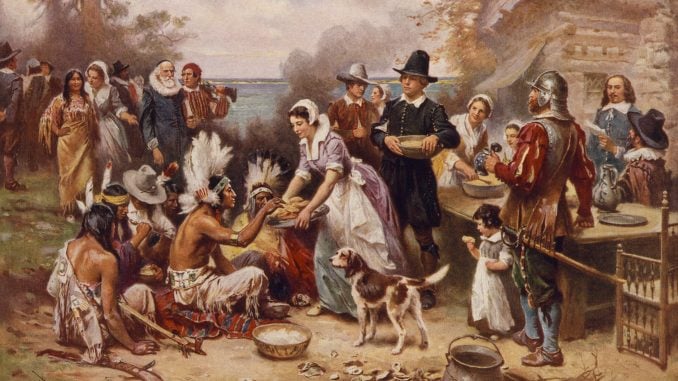
As the nation prepares to observe the Thanksgiving holiday, school children will hear the oft told tale of Native Americans coming to the rescue of the starving new European settlers of Plymouth in 1620, and teaching them new farming techniques that led to a bountiful feast with their new friends the next year, living happily ever after. While it’s a very warm and fuzzy story of multicultural cooperation, it is a mostly fairy tale that discounts the true nature of the pilgrims’ struggle and the subsequent realization for which they gave thanks to God.
The real story of Thanksgiving can be understood by the direct accounts of the Plymouth Colony’s longtime governor, William Bradford, recorded in his diary, titled Of Plymouth Plantation.
According to Bradford, the financial backers of the Mayflower’s fateful journey to the new world stipulated a seven year contract, a communal economic system so as to maximize the return on their investment. This arrangement required “all profits & benefits that are got by trade, traffic, trucking, working, fishing, or any other means” be turned over to the commonwealth of the colony, and “all such persons as are of this colony, are to have their meat, drink, apparel, and all provisions out of the common stock,” wrote Bradford.
The communal system, met with harsh Northeastern winters and lengthy droughts, led to famine and frustration, according to Bradford, as “the young men, that were most able and fit for labour and service, did repine that they should spend their time and strength to work for other men’s wives and children with out any recompense.”
After the first winter of 1621, “that of 100 & odd persons, scarce 50 remained,” for having arrived too late to plant crops. The colonists fared no better during the winter of 1622, Bradford himself losing his own wife and child. In his journal, Bradford laments what he describes as a conceited notion that “the taking away of property and bringing in community into a commonwealth would make them happy and flourishing.”
The thanksgivings of these first two years were in appreciation to God for the mere survival of those still living, and they indeed were joined by friendly natives who contributed to the feasts. The harrowing experience, though, led them to “think how they might raise as much corn as they could, and obtain a better crop than they had done, that they might not still thus languish in misery.”
In 1623, leaders reorganized their economics completely, deciding “that they should set corn every man for his own particular, and in that regard trust to themselves.” Every household received a parcel of land and was able to keep whatever they produced, and trade way any surpluses.”This had very good success,” wrote Bradford, “for it made all hands very industrious, so as much more corn was planted than otherwise would have been.”
The changes proved fruitful, as Bradford recounted that “instead of famine now God gave them plenty, and the face of things was changed, to the rejoicing of the hearts of many, for which they blessed God.”
That year marked the first true Thanksgiving of the Plymouth colonists, as their chosen alignment with the principle of individual property produced so much that they invited all in their vicinity to join them in giving thanks to God for their epiphany. Bradford wrote that they never saw famine again, even exporting surplus corn in 1624.A century and a half later, these same principles spawned a revolution, enshrined in the sovereignty of the Individual, that would lead to the most prosperous nation the world has ever known. For that, we should all be thankful for the real story of Thanksgiving.



